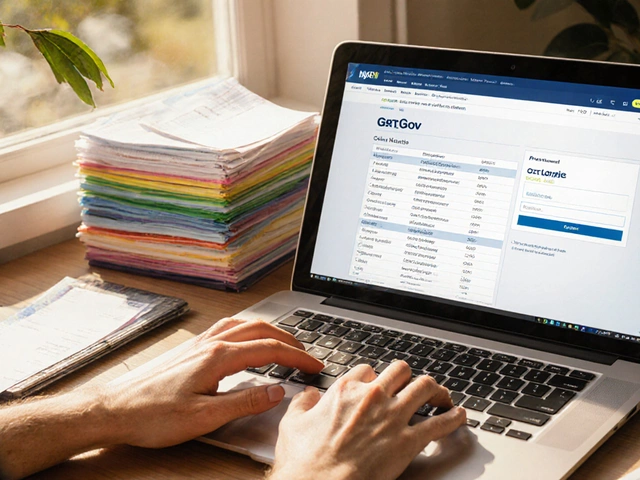
Struggling with the decision between taking a home loan outright or opting for EMIs? You're not alone. Figuring out the most cost-effective and manageable way to finance your dream home can be quite the journey. Let's chat about EMIs, often the go-to option due to their predictable monthly payment structure.
EMIs, or Equated Monthly Installments, allow you to spread the cost of a loan into regular, manageable payments. They offer a structured financial rhythm, which makes it easier to balance your budget. But that's not the whole story. Every silver lining has a cloud, right? It's important to also know the potential downsides.
Choosing between a simple loan and an EMI plan often boils down to your financial situation and comfort with risk. EMIs tend to offer a sense of stability but come with their own set of considerations. In the sections that follow, we'll break down what's involved with EMIs, why they might be your best pick—or why a traditional loan could be the better deal.
- Understanding EMIs
- Pros of Choosing EMI
- Downsides of EMI
- How EMIs Compare to Loans
- Tips for Managing Your EMI
- Making the Right Choice for You
Understanding EMIs
EMIs, short for Equated Monthly Installments, are a popular choice when it comes to financing big-ticket items like homes. They break down the total loan amount into equal monthly payments, making it easier for folks to handle over time. But how exactly do they work?
At the heart of an EMI is a straightforward formula that calculates how much you'll pay each month. This formula takes into account the principal amount, the interest rate, and the loan tenure. The result? A fixed payment schedule that doesn't change, helping you plan your finances with ease.
How Are EMIs Calculated?
The EMI formula is a blend of the principal loan amount 'P', the interest rate 'R', and the loan tenure 'N' in months. Here's the basic formula:
EMI = [P x R x (1+R)^N]/[(1+R)^N-1]
Where R is your monthly interest rate. It's interesting to note that the EMI payment is split between paying off the interest and reducing the principal amount. Initially, a larger chunk goes to the interest, but as you're deeper into the loan, more of the payment reduces the principal.
Why Choose EMIs?
For anyone buying a home where predictable monthly budgeting is key, an EMI can be a lifesaver. Knowing exactly how much will leave your account each month helps in maintaining other financial goals. Plus, many banks offer flexible EMI plans, allowing you to pick the most suitable tenure and interest rate combination.
In recent years, lenders have made it easier than ever to calculate your EMIs using online calculators. These tools require just a few inputs and can give you a snapshot of what your payment terms will look like.
| Loan Amount ($) | Interest Rate (%) | Loan Tenure (years) | Estimated EMI ($) |
|---|---|---|---|
| 200,000 | 3.5 | 15 | 1,429 |
| 300,000 | 4.0 | 20 | 1,817 |
For those juggling several financial commitments or looking to dip their toes into loan options for the first time, understanding EMIs can be a game-changer. They offer a balance of affordability and simplicity, making them a worthy contender on the house-buying front.
Pros of Choosing EMI
So, why do so many folks opt for EMIs over traditional loans when buying a home? It's all about the perks that come with this approach. Let's break it down.
1. Predictable Payments
One of the biggest draws of the EMI system is its predictability. With EMIs, you know exactly how much you'll be shelling out each month. That kind of stability helps in budgeting and financial planning. No surprises, just steady payments.
2. Flexible Tenure
EMIs usually come with flexible repayment tenures. Depending on what suits your wallet, you can choose periods ranging from a few years to several decades. This flexibility means you can tailor the loan to fit your financial future.
3. Lower Initial Financial Strain
Getting a full-blown loan can be financially daunting, especially if it requires hefty upfront payments. EMIs spread this cost out, making it easier on your wallet. You can move into your dream home without worrying about huge immediate expenses.
4. Improved Credit Rating
Steady and timely EMI payments can actually boost your credit score. Lenders love seeing a strong repayment history. So, in addition to owning a home, you're building up your financial credibility.
5. Possible Tax Benefits
Here’s another kicker - you might stand to gain some tax benefits when paying through home loan EMIs. Many countries offer deductions on the interest component. It's like a cherry on top of a financially smart choice.
| EMI Feature | Benefit |
|---|---|
| Predictability | Fixed monthly payments |
| Flexibility | Wide range of repayment terms |
| Initial Financial Relief | Low upfront costs |
| Credit Score | Potential improvement with timely payments |
| Tax Benefits | Possible deductions available |
When you weigh all these benefits, it's no wonder that many home buyers lean towards the EMI route. Just remember, it's vital to read the fine print and understand your financial commitments when signing up for an EMI plan.
Downsides of EMI
While EMIs provide great ease and predictability, they're not without their flaws. First off, the interest part of these installments can add up, especially if your loan duration stretches out over many years. The longer it takes to pay off, the more interest you end up shelling out.
High Total Interest
Interest is the hidden devil when it comes to home loans. Even if monthly payments seem affordable, don’t overlook the grand total by the end of your term. Paying off a loan over 20 years could mean you’ll end up spending an eye-watering sum on interest alone.
Rigidity in Payments
EMIs are inflexible. The set monthly payment needs to be met, no excuses. This rigidity can be a budget buster when unexpected expenses pop up. Unlike a flexible loan where you might negotiate a term change, EMIs demand consistency and discipline.
Early Repayment Penalties
It sounds great to get rid of your debt early, but with many EMI contracts, there could be penalties for doing just that. Prepayment fees are sometimes levied to compensate the lender for the interest they'll miss out on. This might dampen your enthusiasm for clearing off your mortgage sooner.
Lack of Financial Growth
Another concern with EMIs is opportunity cost. By being tied up in a strict payment plan, you may miss out on potential investments that could have turned up a higher return. That monthly commitment could otherwise be growing in stocks or spent on professional development.
| Loan Tenure | Interest Paid |
|---|---|
| 10 Years | $80,000 |
| 15 Years | $130,000 |
| 20 Years | $180,000 |
Make sure you weigh these cons carefully. Being aware about potential pitfalls can save you financial heartache down the road.

How EMIs Compare to Loans
Okay, so you're trying to decide between an EMI and a conventional loan. Let's break it down. Both of these options allow you to borrow money for that home you have your heart set on, but they come with their pros and cons.
Regular Payments vs. Lump Sum
The most obvious difference is payment structure. With EMIs, you pay a fixed amount every month. It’s like a Netflix subscription, but bigger. This means easier budgeting, as you know exactly what to expect. Loans, however, can be more flexible but might require a hefty lump sum down the line.
Interest Rates and Terms
Interest is another big player in this game. Traditional loans might offer lower interest rates, but they can also be variable, which means they might fluctuate over time. EMIs tend to have a fixed rate, giving you peace of mind, but sometimes at a slightly higher rate compared to a straightforward loan.
Flexibility vs. Structure
Think about flexibility. Loans can often allow prepayment without penalty, which can help you save on interest if you come into some extra cash. EMIs, on the other hand, lock you into a fixed schedule, which can either be comforting or constricting, depending on your financial situation.
Impact on Financial Planning
From a financial planning perspective, EMIs add stability and predictability to your monthly expenses. They’re perfect if you want to stay away from surprises. Loans offer a bit more freedom and can be tailored if you’re someone who might want to jump at the chance to pay it off early without penalties.
So, what’s the takeaway? When you’re deciding between a home loan or EMI, think about what your financial habits look like. Are you steady and predictable, or do you like keeping your options open? Answering that might point you in the right direction.
Tips for Managing Your EMI
Managing your home loan through EMIs can seem daunting at first, but with a few strategies, it’s totally manageable. Let’s break down some tips that can make this journey smoother.
1. Know Your EMI Amounts
The first step is understanding exactly how much you're expected to pay monthly. Get this wrong, and it can mess with your whole budget. Make sure you’ve got the correct figures, including principal and interest, so there are no surprises.
2. Set a Budget and Stick to It
A solid budget is your best ally in managing an EMI. Break down your monthly income and expenses, making sure the EMI fits comfortably. Don’t just budget for the here and now; think ahead for possible changes in income or expenses.
3. Automate Your Payments
One simple trick? Automate those EMI payments. Set up a direct debit from your bank account on payday. This way, you won’t risk missing a payment and can focus on other financial goals.
4. Monitor Your Loan Statement
Keeping an eye on your loan statement is vital. It lets you track how much of your payment goes towards interest versus principal. This awareness can spark motivation and help you stay on course.
5. Create an Emergency Fund
Life's uncertainties can disrupt your financial plans. An emergency fund acts as your safety net, ensuring your EMI payments continue even if unexpected costs arise. Aim for 3 to 6 months' worth of expenses as a buffer.
6. Increase EMI with Salary Raise
If you get a raise, consider upping your EMI amount. Paying more monthly reduces the interest over the loan’s life, saving you money in the long run.
7. Use Windfalls Wisely
It can be tempting to splurge unexpected bonuses or tax refunds. But putting some or all towards your home loan can shorten its term and cut interest costs.
Here's a quick look at how increasing your EMI can affect your loan:
| Initial EMI | Increased EMI | Interest Savings |
|---|---|---|
| $500 | $550 | $500 over the loan's term |
| $700 | $800 | $1,200 over the loan's term |
| $1,000 | $1,200 | $2,500 over the loan's term |
With these strategies, your EMI can become just another part of your monthly routine, rather than a financial burden.
Making the Right Choice for You
When it comes to picking between a traditional home loan or going with an EMI plan, the decision boils down to personal financial goals and lifestyle. So, how do you figure out which path suits you best?
Assess Your Financial Situation
The first step is to take a good, hard look at your current and future financial status. Do you have a steady income that supports a fixed monthly payment? Or do you expect fluctuations?
- Stability: If your job is stable and your budget allows for predictable expenses, EMIs can fit well.
- Flexibility: On the other hand, if you anticipate fluctuations in income, maybe a flexible loan arrangement is better.
Consider Future Plans
Are you planning to make big changes soon, like starting a family or switching careers? These factors can heavily influence what you can afford monthly. An EMI plan might seem appealing, but it requires consistent payments over a long term.
Think About Interest Rates
Interest rates can make a world of difference. EMIs often have fixed rates, making them predictable, but make sure to shop around. A little difference in the interest rate can save or cost you thousands over the loan's lifespan. Thanks to online tools, comparing offers is easier than ever.
Evaluate Financial Benefits
What's the end goal? Do you want to pay off your home loan quickly, or is stretching it over a longer period more comfortable? EMIs might offer peace of mind with fixed payments, but sometimes paying off a loan faster might be financially smarter in the long run.
Seek Professional Advice
Don't hesitate to consult a financial advisor to analyze your situation. They can provide insights that you might overlook, helping tailor the best strategy for your circumstances.
Ultimately, go with the choice that aligns with your personal and financial goals. Whether it’s peace of mind with EMIs or flexibility with a conventional loan, what’s important is finding a method that supports not just buying your home, but living comfortably in it too.








Write a comment